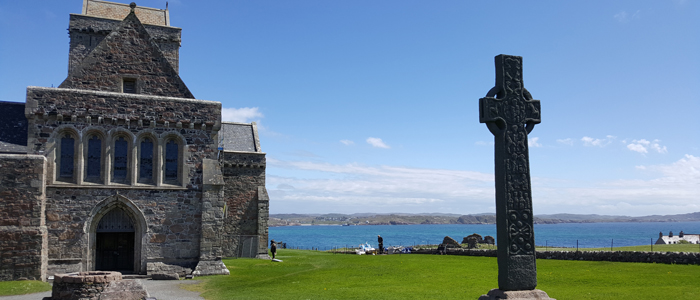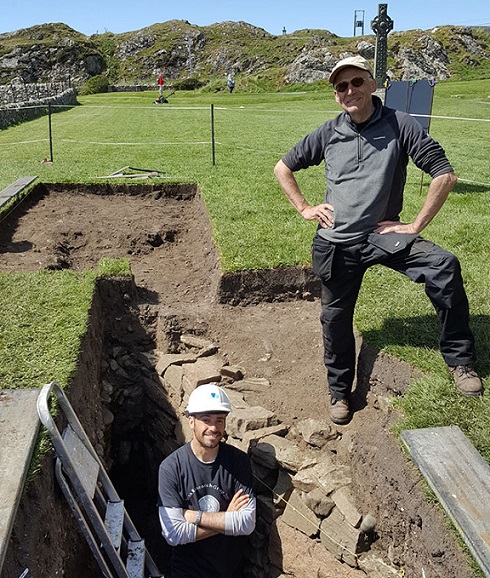Archaeologists Ewan Campbell and Adrian Maldonado featured in BBC 4's Digging for Britain programme on Wednesday 6 December 2017.
Published: 8 December 2017
Archaeologists from School of Humanities | Sgoil nan Daonnachdan on BBC 4's Digging for Britain

Archaeologists from the School of Humanities | Sgoil nan Daonnachdan featured in the BBC 4's Digging for Britain programme on Wednesday December 6 2017.
Dr Ewan Campbell and Dr Adrián Maldonado appeared in the programme to give an insight into their groundbreaking new research on the early monastery of Iona in the Inner Hebrides of Scotland.
Excavations around the site of Iona Abbey in May 2017 uncovered conclusive evidence that a wooden hut traditionally associated with St Columba at the monastery on the island of Iona did indeed date to his lifetime in the late sixth century AD.
Carbon dating led to the significant breakthrough, which categorically proves that samples of hazel charcoal, unearthed from an excavation of a simple wattle and timber structure on Iona 60 years ago, date back to the exact period Columba lived and worked at the Inner Hebridean monastery. It may be the monk’s ‘cell’ where he prayed and studied in isolation.
Iona is one of Scotland’s leading heritage landscapes, owned by the National Trust for Scotland (NTS), with a medieval Benedictine abbey and Augustinian nunnery managed by Historic Environment Scotland (HES). The reconstructed medieval abbey is built on the site of one of Scotland’s earliest ecclesiastical sites, founded by the Irish monk St Columba in AD 563.
The only surviving remnants of the early Christian foundation are a small chapel known as St Columba’s Shrine, a famous group of High Crosses and other carved stones, all surrounded by a massive earthwork enclosure known as the vallum, marking the edge of the sanctuary.
It was believed that very little survived of the earliest monastery, but new radiocarbon dates obtained by University of Glasgow archaeologists earlier this year established the existence of structures dating to the lifetime of St Columba.
“The period after the Vikings and before the Benedictines is kind of an archaeological dark age,” argues Dr Maldonado.
In May this year, Dr Campbell and Dr Maldonado obtained the support of both HES and the NTS to carry out limited new excavations in and around the Abbey complex. They were investigating features excavated by the late Prof Charles Thomas in 1956 and 1957, which he was never able to publish in his lifetime.
The new excavations revealed an unexpected new twist to the history of the site: a large, stone-built wall foundation just south of the current medieval abbey nave. Radiocarbon dates show the wall was built by the 7th or 8th century, and the structure demolished by the 10th or 11th century, when it was disturbed by the insertion of graves in the 11th and 12th centuries.
“This wasn’t supposed to be here,” said Dr Maldonado. “At first, we thought this was potentially an early church, as it is oriented west to east and appears to have a semi-circular east end. However, it is now more likely this is an early attempt to shore up the sloping ground here, for the construction of a large church of some sophistication.”
A second trench excavated through the massive ‘vallum’ earthwork enclosure and ditch system also obtained new dating evidence, proving that this was one of the earliest features of the monastery. Organic material preserved at the bottom of the ditch show that it was open from at least the 7th century AD, within a few generations of the lifetime of St Columba.
Dr Campbell and Dr Maldonado are members of the Iona Research Group, an interdisciplinary collective across the College of Arts which is identifying gaps in the research on the Isle of Iona. The results of their excavations and a summary of all radiocarbon dating evidence obtained to date are being made available free online through their project page.

First published: 8 December 2017
<< 2018

